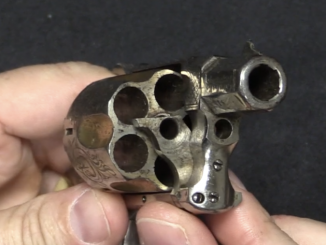This is lot #183 in the upcoming RIA Premier Auction. It was scheduled for April, but has been postponed – check their web site for upcoming Online Only auctions every month, though!
This is a fascinating experimental Remington Keene rifle, build in an attempt to alleviate concerns about magazine tube detonation. With centerfire ammunition in a linear tube magazine, there was an ever-present (if very slim) risk of a bullet detonating the primer ahead that it was resting against. Remington’s experiment here was to add a second magazine of donut-like spacers to separate bullets from primers in the magazine. These spacers were manually inserted between cartridges when loading the rifle, and they were automatically returned home when cycling the action, so as to not be disposable items. The system was clearly too complex to be practical, and the move to box magazines removed the issue entirely before long.
Interestingly, this prototype was also designed to cock automatically when the bolt was closed, where the standard production Remington-Keene rifles head to be manually cocked.




This is not the most Rube Goldberg magazine you’ve ever covered, but it deserves a participation trophy!
I think the French had a simple solution: craft cartridge base to keep bullets away from primer in tube. I could be wrong.
8 x 50R Lebel;
https://translate.google.com/translate?hl=en&sl=es&u=http://www.municion.org/8x50r/8x50r.htm&prev=search
When the spire-pointed bullet superseded the round-nosed one, the Lebel case was redesigned with an annular groove in the case head surrounding the primer pocket. When rounds were loaded into the tubular magazine of the Lebel bolt-action rifle, this groove caught the nose of the bullet and kept it away from the primer.
cheers
eon
“(…)risk of a bullet detonating the primer ahead that it was resting against(…)”
Did anybody tried to solved it by using fully buried bullets – imagine something like Nagant 1895 cartridge, but for rifle?
“(…)spacers were manually inserted between cartridges when loading the rifle, and they were automatically returned home when cycling the action, so as to not be disposable items.(…)”
Now imagine that you lost one spacer in field condition or after finishing load start have doubts if every cartridge has own spacer.
A buried bullet approach would prevent primer detonations, assuming that your cartridge brass was of consistent quality and did not easily buckle. You also have to train your men not to MASH the cartridges into the magazine (not that anyone can really do that).
“the spacer goes back into its little house …” How charming!
Not such a strange idea if you remember that wadding, as a separate loading element in muzzle-loaders, was still floating around in gun designers’ memories. Re-usable wads that never left the gun! If you consider such other devices as tape primers, and whatever Sharp’s offered for awhile that extended a primer cap (from a tube in the lock) onto the nipple each time you cocked the hammer, this is almost reasonable.
Cartridge?
If typical flat nose of the period, is tube det even possible?
Proposed presentation protocol enhancements:
1. Always mention the cal. & ctg.
2. Consider setting one or more dummy rounds on the table.
I would think that with today’s home 3D printers, and web data on ctgs, it would be possible to knock out some show&tell dummies pretty easily (if not actually functional), where not already available as snap caps & such.
You could probably find nylon washers of the right diameter and thickness in the plumbing section of Lowe’s or Home Depot.
Or just order them from Amazon;
https://www.amazon.com/nylon-washers/s?k=nylon+washers
Diameters up to .75 in, thicknesses up to 0.5 in. A package of 100 averages about $10.
I doubt you could 3D print them for the equivalent of a dime apiece.
cheers
eon
“(…)3D printers(…)”
Cartridge are generally solid-revolution https://en.wikipedia.org/wiki/Solid_of_revolution
so maybe some lathe?
Interesting to me how something like this would have gotten outside of Ilion’s walls. Someone in engineering take it home to play with and forgot to bring it back? They sold or gave away their backroom of experimentals and prototypes?
A bit of both.
Here’s what one experiment showed- you CAN make it appen, but the results are unspectacular with 30-30 smokeless. I think I’ll try it with black powder 45-70.
http://castboolits.gunloads.com/showthread.php?263616-lever-action-magazine-explosions&p=3063484&viewfull=1#post3063484
By the way: I think, Pedersen’s solution is the smartest (Magazine for firearms. US1043354, patented Nov. 5. 1912. [https://patentimages.storage.googleapis.com/91/b5/21/35e5f7cc703f82/US1043354.pdf]), which can be seen on the Remington Model 14.
Cock-on-close, as God and James Paris Lee intended.